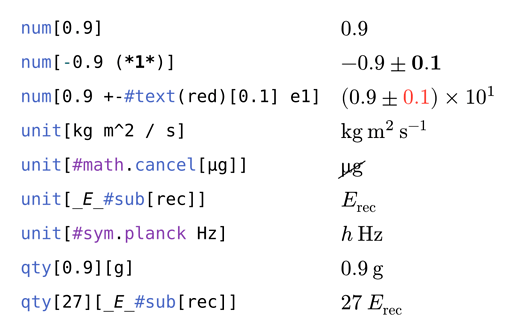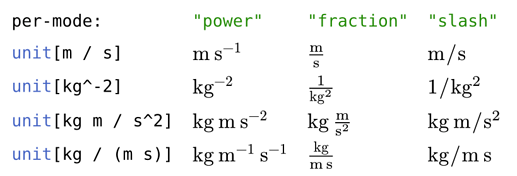If you are thinking “why would we possibly need another units package?”, I can assure you that fancy-units actually brings something new to the table. While the existing packages are just aiming to be ports of siunitx, I tried to design the package to work/feel like native Typst. The input of numbers and units is entirely content-based, and you can use this to style (parts) of the numbers and units with the built-in Typst functions. There are also no unit macros necessary, you can just write down the units like regular text, and by default the decimal separator is directly inferred from the text language.
A few examples
Configuration
There are a few options to change the output format of numbers and units. Most importantly the uncertainty-mode to use absolute or relative uncertainties, and the per-mode to use regular fractions, in-line fractions or powers. For the full documentation, please see the manual.pdf
You can change these options through a state for an entire document/scope
#import "@preview/fancy-units:0.1.0": fancy-units-configure
#fancy-units-configure(
uncertainty-mode: "plus-minus",
per-mode: "slash",
...
)
or individually for each number and unit
#import "@preview/fancy-units:0.1.0": num, unit
#num(uncertainty-mode: "parentheses")[0.9(1)]
#unit(per-mode: "power")[W / kg]
Where to start?
If you are curious by now and want to play around with the package, you can use the following examples to get started
#import "@preview/fancy-units:0.1.0": fancy-units-configure, num, unit, qty
#fancy-units-configure(
uncertainty-mode: "conserve",
per-mode: "fraction"
)
$
#num[123*(4)*e5] \
#unit[kg m / s^2] \
#qty[137][#text(red)[μ]:m] \
#qty[1][M:#sym.Omega] \
#unit(per-mode: "power")[kg / m^-2] \
#unit[F] = #unit(per-mode: "fraction", unit-separator: sym.dot)[(s C)^2 / (m^2 kg)] \
#unit[kg#math.cancel[^2] / #math.cancel[kg]] = #unit[kg]
$
Planned features
So far I am still planning to implement the following features:
- Macros for custom units (I am already getting annoyed by having to type
_E_#sub[rec]all the time…) - Support more built-in (styling) functions
- Digit grouping to make long numbers easier to read (299 792 458 instead of 299792458)
If you have any suggestions or ideas how I could further improve the package, please let me know. ![]()


